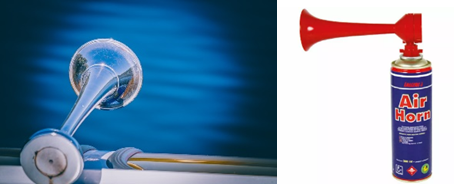Do YOU know them?
This is a brief article to reinforce what sound signals are for!
We recently had a call from a newcomer to the maritime industry who had purchased a <12 mtr commercial charter vessel undertaking harbour tours.
And, he did not have any experience or tickets and was using a Coxswain to operate the vessel. While this is becoming more common nowadays being boarded by the Water Police was not something he expected.
The Water Police were contacted owing to the ongoing use of a sound signaling device which left other operators wondering what the vessel was doing. Along with that, some harbour front residents were complaining about the noise level.
So, two issues :
1. First being – using a sound signal without knowing what they are for; and
2. Noise pollution!
Now, let’s look at what sound signals are used for.
Sound Signals can be by the vessel horn or a portable compressed air horn as pictured below.

The compressed air horn as pictured above is a recognised sound signaling device both by AMSA and internationally.
They indicate your intended actions so as other vessels in the area know what you are about to do.
The use of sound signals including the use of hand-held horns just for fun can lead to confusion with other mariners as they won’t know what you’re doing.
Noise pollution from sound signals, music and general partying can cause issues with other vessels and more importantly waterfront households, especially around Christmas and the new year.
While it seems like a lot of fun, there are specific limits to actual levels of noise that all operators must comply with. Sound signaling devices are designed to deliver very loud levels of noise aimed at alerting others to a danger.
If you operate a passenger vessel where noise can or is a potential problem, develop a policy covering noise pollution because… you don’t want to end up with the Water Police paying you a visit during a cruise and potentially receiving a fine. Not a good look at all!
Our recommendation is to ensure you and your crew know what sounds signals are for and can easily identify each one.
We also recommend that you think before letting off ANY sound signaling device just for fun because another vessel may think that you are taking a specific action when you’re not which could put you in a potentially dangerous situation.
Take the time to ask your crew what each of the 5 sound signals means because they may be in a situation where they hear one and need to take action accordingly.
While many know what 1, 2 and 3 blasts mean, not so many know what 5 short blasts or 1 long blast means. It’s a great tip to ensure ALL know the 5 sound signals.
A good tip is don’t use a sound signaling device unless it’s necessary.